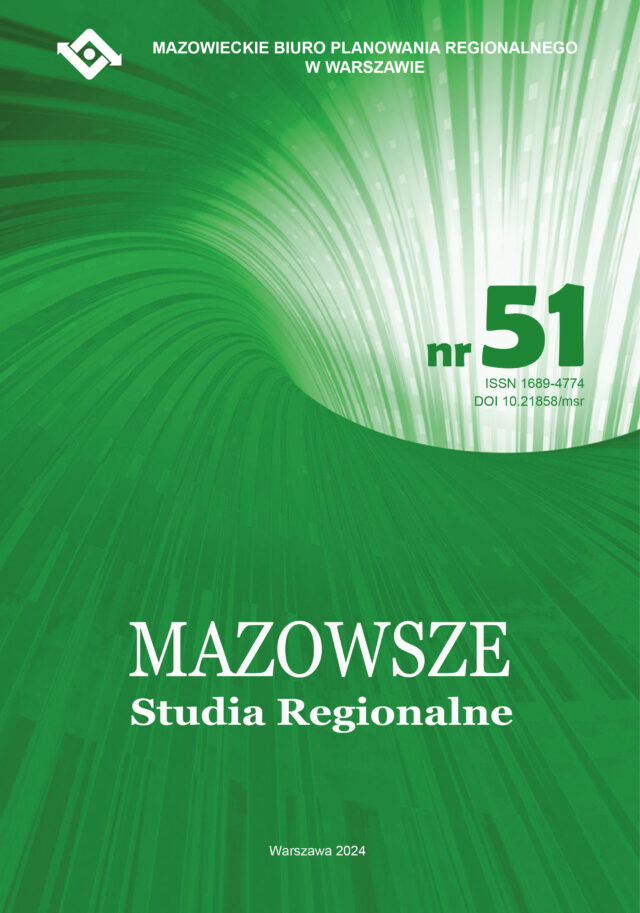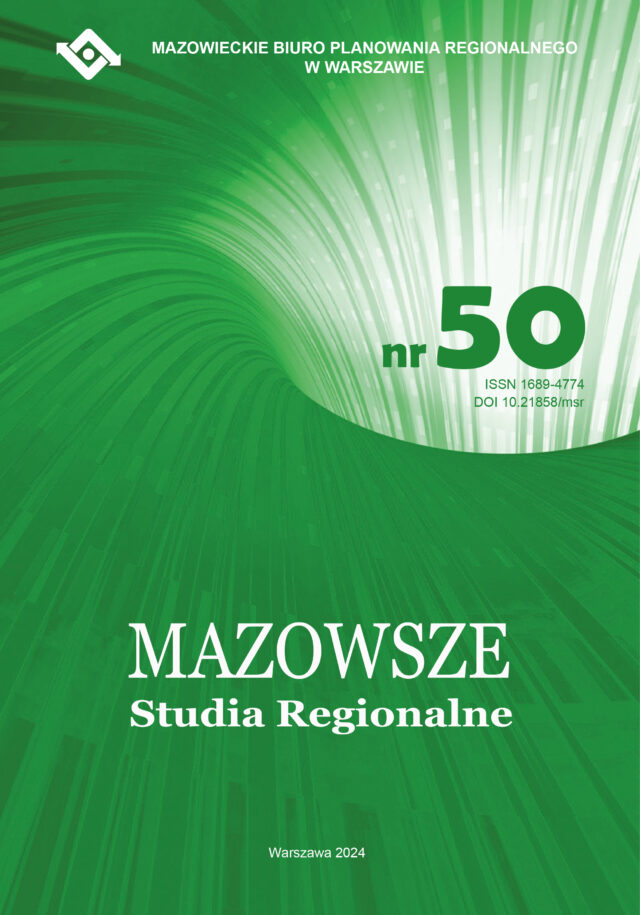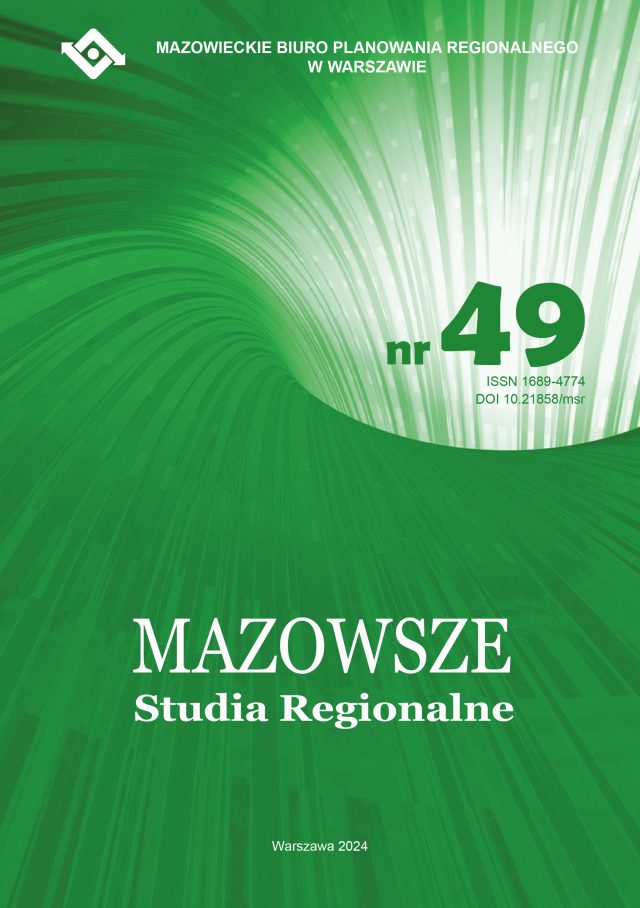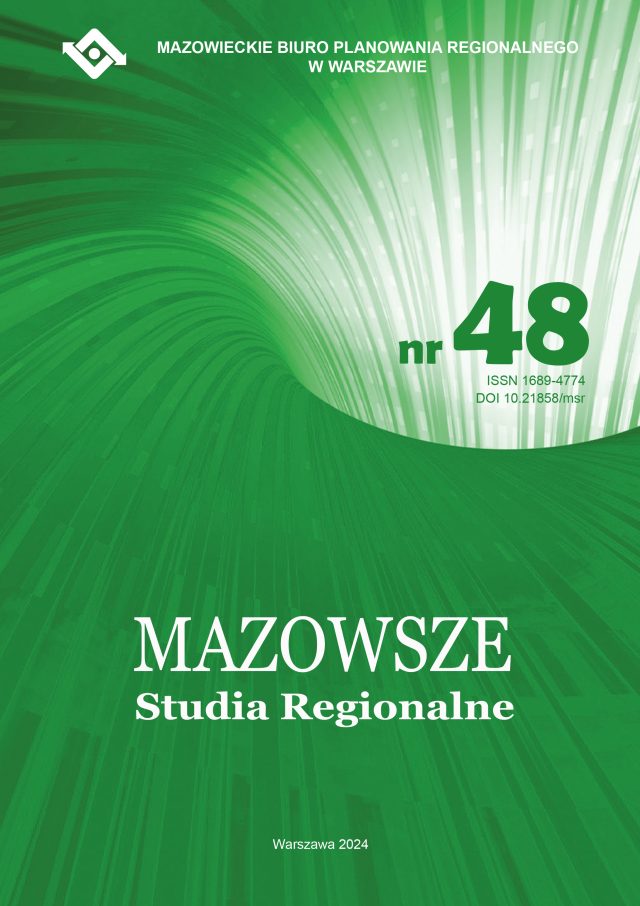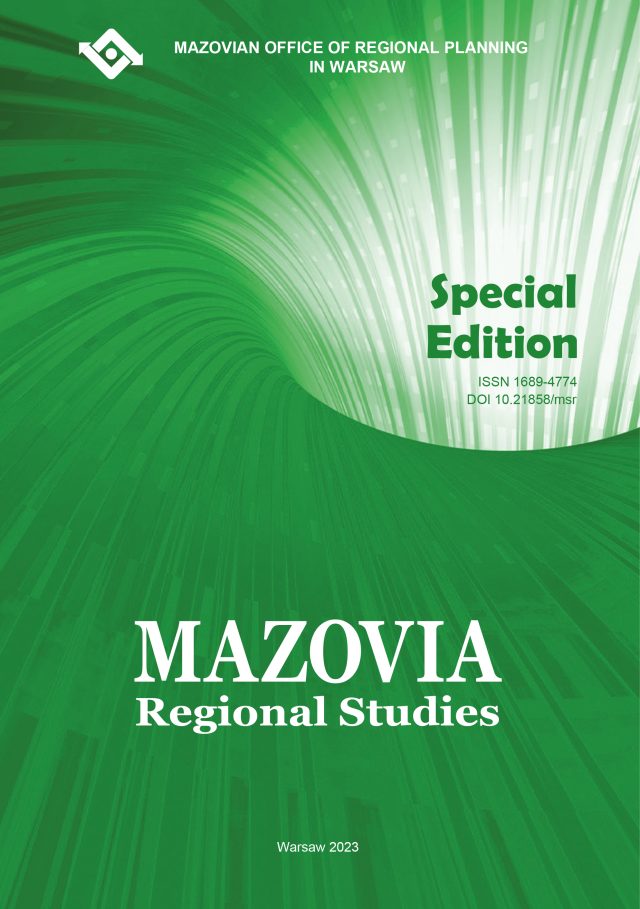
The periodical “MAZOVIA Regional Studies” is a quarterly issued by the Mazovian Office of Regional Planning and the only scientific journal redacted by the self-government. We publish articles focused on the mission of science in a broad sense and self-governments for the development of local communities.
ISSN of printed issues: 1689–4774
ISSN of on-line editions: 2543-4373
DOI: 10.21858/msr
Stop or play automatically change of publications
In the latest editions
-
Piotr Szpiega
DOI: 10.21858/msr.52.04
Vol. no: 52
The article attempts to determine whether there is a need for designating new allotment sites in Radom. To this end, the statutory competences of the local government in relation to allotments were analysed, i.e. taking into account in the city’s spatial policy, allocating land for the establishment of allotments, providing access roads and taking into account the needs of allotments in the organisation of public transport. In addition, the surface areas of allotments in Radom were compared to those in cities similar in terms of population and surface area, as a result of which the additional surface area of allotments in Radom was specified, required to be planned in order to match the average indicators of similar cities, ranging from 27.1 ha to 105.7 ha. The spatial, proprietary and communicational analyses were performed using GIS tools and field visits. In the scope of the analysis of the city’s spatial policy, the emphasis was put on how the city’s planning documents (Study of Conditions and Directions of Spatial Development and Local Spatial Development Plans) take into account allotments. As a result of the balance of the surface area of allotments taken into account in the planning documents, it turned out that as a result of the implementation of the city’s spatial policy, over 7 ha of gardens will be lost. The next part analyses the ownership of the plots of land on which the existing allotments are located and identifies the allotment sites located on private land, which may in the future lead to the liquidation of 5.7 ha of allotments on this land. The next stage analyses the accessibility of existing allotments by various means of transport (on foot, by bike, by public transport) in a given period based on the analysis of the literature. As a result of this research, postulates were formulated, improving the accessibility of the gardens on foot and by bike. The missing surface area of gardens resulting from the spatial and proprietary analyses was planned in the minimum variant (13 ha in total) in the city, taking into consideration the location factors included in the literature and the city’s Study of Conditions and Directions of Spatial Development. Previous accessibility analyses (access and approach isochrones), spatial data and data from the city study were used to designate conveniently located sites. The compliance of the location of selected sites with location factors is presented in a table, and the new sites are presented in a figure using data from the city study.
MSR_52_04_Szpiega-1Pobierz -
Olga Góral, Maciej Siekierski, Anna Wieczorek
DOI: 10.21858/msr.52.01
Vol. no: 52
As societies become more affluent, cosmetic products are becoming indispensable in the daily lives of more and more people. Statistics and forecasts based thereon indicate that demand for cosmetics will increase. The cosmetics industry is one of the fast-growing sectors of the economy, bringing large profit. However, cosmetics manufacturing processes can have a negative impact on the environment, for example by generating waste. The aim of this article is to present typical waste generated during the manufacturing of cosmetic products and to demonstrate methods of handling such waste.
MSR_52_01_Goral_Siekierski_Wieczorek-1Pobierz -
Marcin Dwórznik
DOI: 10.21858/msr.52.02
Vol. no: 52
The main objective of the article is to indicate the role of economic calculation when planning business activities. The article also draws attention to the so-called cooperation using agricultural cooperatives and clusters. It was indicated that when planning business activities, it is not only important to correctly determine revenues and costs, but also to assume the feasibility of achieving the assumed sales plans. Another conclusion is that one should not base one’s business on only one source of revenue. In addition, maintaining accounting liquidity, i.e. being able to meet one’s obligations on an ongoing basis, is a key and indispensable factor for success.The article also indicates the importance of proper organisation of the supply chain from the producer (farmer) to the end consumer. Cooperation of producers at the very beginning of the supply chain in the form of, for example, a cooperative or agricultural cluster can bring a positive result. The correct organisation of the supply chain can also be beneficial for the economy of the region. All considerations were carried out on the basis of an analysis of the profitability of hemp cultivation.
MSR_52_02_Dworznik-1Pobierz -
-
-
Dominika Jędrzejczak, Jan Cieplak, Aleksandra Kępińska, Patrycja Poniewierska, Aneta Zyskowska
DOI: 10.21858/msr.51.01
Vol. no: 51
Local authorities have been facing significant pressure in recent years to review municipal development policies and update their strategies in response to emerging challenges and legal requirements. In 2020 and 2023 new legislation was enacted in Poland that initiated a reform aimed at integrating the strategic planning system and the spatial planning system, among others, at the local level. This paper presents the main changes in the legislation related to the municipal development strategy, and the subsequent challenges in spatial policy-making. In this context, the evaluation was made of the currency of the municipal development strategies of the Warsaw Functional Urban Area. The analysis demonstrates that the integration of socio-economic and spatial aspects of development policy at the local level is being implemented slowly, with the result that local authorities may not be adequately prepared for the legal environment that will exist from 2026 onwards.
MSR_51_01_Jedrzejczak_Cieplak_Kepinska_Poniewierska_Zyskowska-1Pobierz -
Tadeusz Wójcicki
DOI: 10.21858/msr.51.03
Vol. no: 51
A cursory comparison of the transport status of the Kalisz agglomeration with the similar-size agglomeration in Poland, e.g. Kielce agglomeration, leads to the conclusion that Kalisz and its surroundings, including the neighbouring city of Ostrów Wielkopolski, are relatively underinvested in transport. The symbol image of underinvestment is the complete lack of highways or expressways connecting Kalisz with other agglomerations and the lack of fast railway connections with the nearest agglomeration. In this regard, this article aims to examine what the target transport system of the Kalisz agglomeration should be. To achieve this goal, it is necessary to describe the current state of the agglomeration, develop a theoretical model of the transport system, diagnose the condition of the existing system, present the assumed development plans for this system, analyze and evaluate them, and finally specify the optimal target system for the agglomeration.
MSR_51_03_Wojcicki-1Pobierz -
Jakub Botwina, Beata Fortuna-Antoszkiewicz, Jan Łukaszkiewicz
DOI: 10.21858/msr.51.04
Vol. no: 51
The area where the Culture and Recreation Park in Chorzów was established consisted primarily of degraded post-mining areas, spoil heaps, landfills, sinkholes and marshes. In 1950, due to the initiative of General Jerzy Ziętek, the governor of Silesia, it was decided to establish one of the largest urban parks in Europe on the border of Katowice, Chorzów and Siemianowice. The design was commissioned to Professor Władysław Niemirski of the Warsaw-Ursynów School of Landscape Architecture at the Warsaw University of Life Sciences. The implementation work began in 1951 and lasted for almost 20 years until 1968. The park’s programme was designed to offer a great variety of recreational and natural functions, making this project unique both in Poland and in Europe. Among the numerous attractions, several objects deserved special attention, such as the Amusement Park, the Silesian ZOO, the planetarium, an extensive water system and a forest zone. The modernity of the park can also be demonstrated in the diversity of its internal transport system with a wide walking promenade, numerous paths for pedestrians and cyclists, as well as a narrow-gauge railroad and a cable car, which provide access to the most distant parts of this nearly 600 ha area. Along the central axis of the park, a series of theme gardens were designed, and only some of these have been created. The most important of these, designed by Professor Edward Bartman, are the Rose Garden and Japanese Garden, which have beenonly partially completed. In the cooperation between the Department of Landscape Architecture, Warsaw University of Life Sciences and the Silesian Park, a comprehensive natural inventory and a series of pre-design analyses of the area were carried out between 2014–2016. The concept for the modernization of the Japanese Garden was developed in the next stage, followed by a construction project and a building permit. The work on the detailed documentation was completed in the autumn of 2016. The project was completed and commissioned in July 2021. In 2023, it won the internauts’ vote in the Public Space category of the Poland Architecture 2022 Poll. The paper presents the key results of the spatial analyses carried out, the programme, assumptions and methods, and selected design solutions related to the design and implementation of the Japanese Garden in the Culture and Recreation Park in Chorzów.
MSR_51_04_Botwina_Fortuna-Antoszkiewicz_Lukaszkiewicz-1Pobierz -
Elżbieta Mączyńska
DOI: 10.21858/msr.48.01
Vol. no: 48
The analyses presented in this study are focused on identifying new trends and challenges in the healthcare sector, primarily stemming from the ongoing global civilizational turning point as a consequence of the fourth industrial revolution, the digital revolution with its unimaginable potential of artificial intelligence. In such conditions, solutions aimed at optimal utilization of new technologies are particularly crucial, especially those addressing irregularities that result in the wastage of material and intellectual potential in this sector. In the face of almost chronic shortages in healthcare funding sources, characteristic not only of Poland but also many other countries, the rationalization of the utilization of available resources becomes of paramount importance. In Poland, this is particularly significant due to relatively low expenditures on healthcare, both in absolute terms and in relation to GDP. This is confirmed by the international statistics presented in the article. In this context, the article highlights selected rationalizing directions for changes in the national healthcare system.
MSR_48_01_Maczynska-1Pobierz





